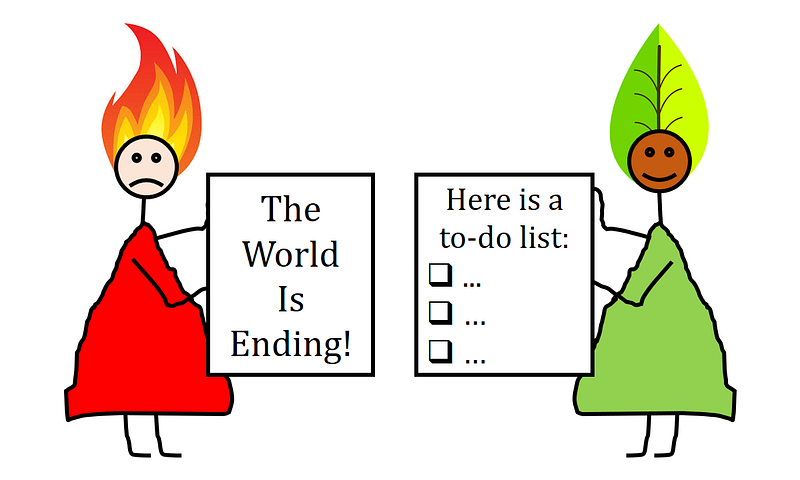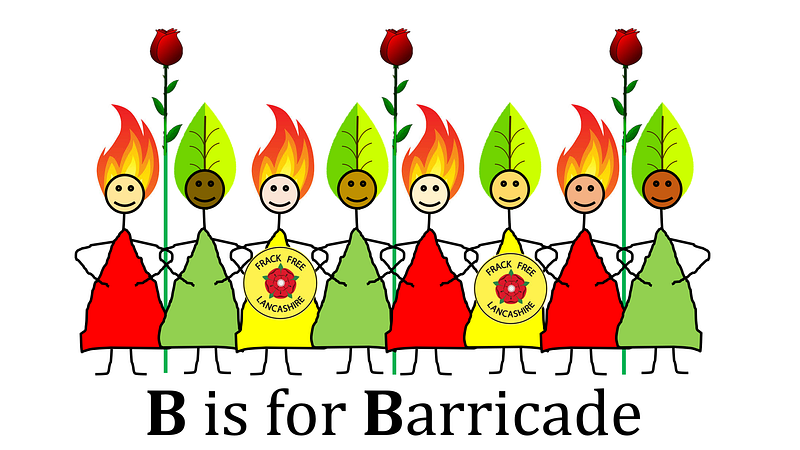An Audacious Toolkit: Actions Against Climate Breakdown (Part 1: A is for Advocacy)
What can we do when confronted with planetary catastrophe? The answer is EVERYTHING. Wait, wait. This is not an overly optimistic “Change is easy and painless! We just all need to do X Y Z!” column. The news is grim, okay?
No one who has looked at latest report on the challenges of achieving 1.5 degrees warming by the Intergovernmental Panel on Climate Change, the WWF’s report on mass extinction of wildlife, or the millions of years worth of damage we have done to our own branches of the tree of life can be “optimistic.” In fact, you can tell who those people are by the dark circles under their eyes and the “WORLD IS ENDING” signs they are holding, right? (And can you believe those three dispatches from the Bad News Fairy were all delivered within the course of the last month?!?) But we can do some things.

We can use our overlarge upright biped brains, our immense critical faculties, our phenomenal capacity for social and cultural organization, our genius for imagination, inventiveness and innovation, and try to figure out, together, how to shift the course of monumental events.
Just as I am trying, through these words, to reach into your lives and draw you out, through encouragement and ideas, to be a bigger, braver, more audacious version of yourselves, you will have to find words and actions to reach into the lives of others and do the same.
So “the answer is EVERYTHING” means that we had better bloody well figure it out, as an active, muddling, messy process: together.
The Audacious Toolkit, Collective Action Version
Working together with others to avert the worst of climate change is the most effective form of action, one with far reaching consequences. From the perspective of the global economy, collective action generally targets the pipeline, the supply side: fossil fuels and their associated industries (automotive, flying), as well as investment in high carbon infrastructures (roads rather than rail, for instance). The most important single thing is turning off that pipeline.
Going beyond our personal sphere
Most of us have probably been limiting our range of action on many issues to a fairly personal sphere: making changes in purchasing habits, signing petitions, considering the issue when voting for candidates. Every single one of the actions I discuss below involves going beyond that comfortable and familiar sphere. What does that mean for you? How do you go about it, when it is new and foreign?
First of all, you don’t need to do everything at once — indeed, that would probably be a good recipe for burnout and disaster. I would recommend choosing one (this handy flowchart might help you!), while being aware that the others are important and interconnected, so that you are ready to make friends and links with other groups. As you build your abilities, you may be surprised at how quickly you end up contributing to each of these areas. So without further ado, an alphabet of collective climate action and suggestions of related groups (if I’ve missed out your group, please let me know in comments and I’ll gladly add it).
A (partial) Alphabet of Collective Climate Action
A is for Advocacy
Advocacy is communication for a cause. In the context of climate breakdown and ecological crisis, one of the main barriers to change is an immense deficiency in understanding in almost every layer of society. This deficiency means that key actors, as well as the larger public, are unaware of both the problem (its severity, scale, urgency and specificity), and their possible role in bringing about solutions. Even scientists fall into this trap: I’ve heard science communicators tell audiences of children to just “recycle more” (hmm-no, that won’t do it).

Taking on the role of advocate means talking to people, over and over and over, in person if possible, by other means if necessary. It means putting yourself on the agenda at existing meetings (community groups, churches, schools, workplaces …) and providing your view on what ecological crisis and climate breakdown mean for that group, as well as what they can do about it. It means organizing meetings with community leaders (best if you bring a friend), and insisting on talking to them about what climate breakdown means for your shared future. It means making the various actors and institutions in your community aware of the magnitude and urgency of the problem. It means exposing the giant gap between current measures and what truly needs to happen to remain below both 1.5 and 2 degrees warming. And it means providing the people within these groups for avenues to act rapidly for positive change. You don’t need to be an expert or have all the answers: if you are human being who cares, you have all the qualifications required to become an amazing advocate.
There is no hard and fast recipe to become an advocate, but lots of material support abounds. Sydney Azari wrote a fantastic section on the harsh truths of climate education. Katharine Hayhoe is a climate scientist & communicator with an excellent youtube channel, to get you started. Gavin Schmidt, Kate Marvel and Kevin Anderson are excellent communicators with a wealth resources to learn from. The incomparable Eric Holthaus covers climate from the news angle. Genevieve Guenther founded EndClimateSilence.org to compel the media to connect the dots between climate breakdown and the stories it is covering. The Centre for Alternative Technology in Wales has an excellent resource around Zero Carbon Britain, and how to achieve this ambitious goal, and Project Drawdown has a compelling list of climate solutions (one quibble with these: they don’t mention the crucial importance of shutting down fossil industries as a core action and goal. It’s not enough to give birth to the new, we must also bury the old).
B is for Barricade
All over the world, fossil fuel companies are exploring and extracting, transporting and transforming, looking for ever new and ways to produce their dangerous products. Just last month, they started fracking (shattering the ground to extract gas) just north of where I live in Manchester, at the Preston New Road site. Right now, they are tentatively considering exploring in the Arctic: due to low levels of ice (thanks to the climate disaster they themselves have caused!) fossil reserves may now become accessible. That’s the bad news.

The good news is that we can stop them. B is for Barricade. The groups in this section work at the coal face (joke?) of climate protection. They make a barrier of their bodies, at the extractive frontier, against extraction, exploitation, pipelines, deforestation, motorway and airport expansion. They call themselves the Water, Earth and Air Protectors. They are the superheroes of the planet (a point which was immediately obvious to my five-year-old son, when we visited Preston New Road).
This form of action is particularly important: it brings visibility to the local devastation caused by global fossil capitalism. Because of their effectiveness, these actions cause the mask of our market economies to slip, and expose the naked power and greed of extractive industries lying underneath. Because of this, and because locations of intense environmental damage are often in poorer or marginalized communities, the police and paramilitary repression of these actions can be severe, going from outrageously long (now overturned!) jail sentences for anti-fracking protestors in the UK to outright murder of environmental defenders world-wide.
One way we must all protect the Protectors is through our unrelenting solidarity and attention to their cause.
An even better way is to join the Earth’s own Avengers, and become Water, Earth and Air protecting superheroes ourselves. Fossil expansion is occurring all over the world, and very likely somewhere near where you live. This is as good a place as any to make a stand and fight this industry, strengthening your community in the process.
C is for Civil Disobedience
“I am not one of those people who goes to protests,” said one of my good friends just a couple of weeks ago. “I care about the climate. I am terrified for my children’s futures. But my car is too convenient, and we will go flying on holidays. I just want the government to make flying and driving illegal: then I wouldn’t be tempted to do it, like everyone else is.”
This kind of sentiment is far from uncommon — I encounter it almost daily in others, and experience it myself. It’s understandable: if we are really facing planetary crisis, then surely the grown-ups, the serious people, the government, would have noticed and stepped in already? Sadly, this is not the way reality happens. Our governments sway in the winds of many forces, and the fossil industries and their friends are past experts in bending them to their will. Indeed, fossil fuel industries have grown up with our governments, and effectively own departments and ministries (for road building and aviation for instance): they are not on the barricades, outside trying to get in the castle, because for all practical intents, they already run the castle. It’s now our job to get them out.

Civil disobedience is the tool that enables us to do just that. It makes us into a force that compels governments and politicians to change direction, to act differently, to work for us, rather than for fossil capitalism. What does climate civil disobedience look like? For one thing, it looks young.
In September, Greta Thunberg, a 15-year-old Swedish girl, couldn’t face starting school again: why should a child learn for a future that the actions of grown-up politicians were denying her? She started a school strike, sitting every Friday in front of the Swedish Parliament, to insist that her government take her future, and that of her fellow students seriously. The school strike for climate movement is now growing world-wide. In the US, teenager Jamie Margolin and her friends started ThisIsZeroHour and organized a climate youth march.
Because of woefully insufficient government action, and the latest urgent report from the IPCC, serious movements to spur rapid and effective public action on climate breakdown are happening around the world. In the UK, this movement goes under the name Extinction Rebellion, and is supported at the highest levels by academics, religious leaders and politicians. It plans a day of demonstration in London on November 17th. In a heartening union of social equality and environmental sustainability, veterans of Occupy and climate action coalition 350.org are both supporting this movement.
Present at the launch of Extinction Rebellion, Green Party Member of the European Parliament Molly Scott Cato, explains it best: “Direct action and civil disobedience are now needed to force governments to see that our survival as a species is at risk.” There are groups planning civil disobedience on climate and ecological crisis worldwide: find the one closest to you, participate if you can, support them in other ways (such as amplifying their messages, and supporting their statements to your circle of friends and family) if you cannot. We must become a large wind, large enough to move government to our side.
To be continued …
In Part 2, I’ll cover: D is for (you guessed it!) Divest, E is for Election, and L is for Lawsuit. (F, G, H, I, J & K somehow didn’t make it.) [Update: Part 2 is live!]
And in Part 3, we get to the thorny issue of individual vs. collective actions, and how we use them to build upon each other.
Previous writing on climate breakdown, capitalism and democracy here.
